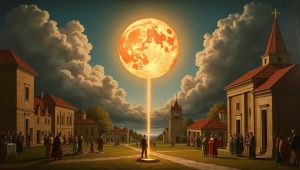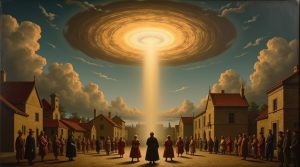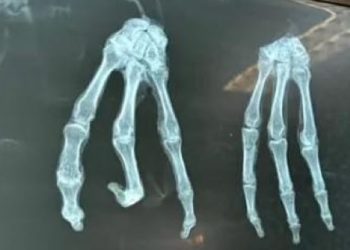Historical Artworks Featuring UFOs
Artists around the world have painted enigmatic sky objects, and UFO enthusiasts have named favorites. Below is a list of notable artworks often cited as “UFO art” (with dates and highlight descriptions):
-
Masolino da Panicale, The Miracle of the Snow (c. 1428–32): This altarpiece shows the Virgin Mary and Christ on a hill as unusual disc-shaped clouds dot the sky. Artnet notes that the lenticular clouds in the panel “look akin to a fleet of alien spaceships” hovering above the scene. Legend says the snow fell miraculously on Rome’s Esquiline Hill, but modern eyes see saucer shapes.
-
Jacques Legrand, Livre des Bonnes Meurs (c. 1430): In this illuminated manuscript, the goddess Fortuna stands by her wheel as a gilded sphere floats over villagers. Critics wonder if that golden orb is the sun, a balloon, or a UFO. The Artnet report highlights it as a “striking image” – one that ufologists have zeroed in on, since “no one has figured it out”
-
Domenico Ghirlandaio (attributed), Madonna with Saint Giovannino (15th century): Nicknamed “Madonna dell’UFO,” this Florentine altarpiece depicts Mary shielding Jesus and John while an odd blob drifts in the blue sky on her right. According to legend, locals in Florence have long pointed to that dark round object as a UFO, even as art experts say it was meant to symbolize something like a cloud or a godly signnews.artnet.com.
-
Michael Pacher, Saint Augustine and the Devil (c. 1475): Augustine kneels before a grotesque demon with green skin and glowing red eyes. Some readers half-jokingly call the creature an alien because of its eerie, inhuman form. Artnet points out that to some viewers “the Gothic painter’s grotesque demon… is less mythical and more extraterrestrial,” turning this religious scene into an “artistic proof that we’re not alone”

Interpretations and Theories
Why do people see UFOs here? Proponents of “ancient astronaut” ideas argue that traditional explanations miss the obvious technology in these images. Shows like History Channel’s Ancient Aliens popularized the notion that medieval artists depicted real spacecraft. Indeed, as Artnet wryly asks, are we looking at an alien presence or symbols of religious rapture? UFO enthusiasts point to the precise shapes, symmetry, and unexpected placement of these objects as evidence of intentional realism.
Mainstream experts disagree. Art historians emphasize that these objects were known symbols of the time – not misdrawn rockets. Dr. Michael Heiser, a scholar of ancient texts, flatly calls these theories “nonsense.” He notes that “the objects in these paintings are not flying saucers or UFOs. They are well known to real art historians”drmsh.com. In other words, to an art historian it’s obvious that a shining orb or halo = divine power, not a little green man. Similarly, art historian Diego Cuoghi (cited by critics) explains that such motifs are simply religious or natural phenomena. For example, he interprets the orb in Crivelli’s Annunciation as a holy “vortex of angels,” and the shapes in Masolino’s Miracle of the Snow as mundane lenticular clouds
Skeptical scientists also offer terrestrial explanations. The 1561 Nuremberg event, depicted by Glaser, was likely a complex optical phenomenon like a sun dog (parhelion) rather than a UFO battleen.wikipedia.org. Even those intrigued by UFOs admit that atmospheric tricks can mimic strange skies. In short, most academics see these examples as artful symbols – heavenly signs, allegories, and meteorological oddities – rather than aliens.
Cultural Context Behind Alien Depictions
These paintings were made for devout audiences. Artists filled religious scenes with visual cues understood at the time. Glowing disks, radiant clouds, and winged figures were common shorthand for divine action. The golden “lights” in these works often signify the Holy Spirit or celestial glory. For instance, de Gelder’s plate-beam in The Baptism of Christ is explicitly tied to the biblical verse about God descending as a dove. Similarly, the medieval idea of fortunam tanta in the Legrand manuscript uses a gleaming orb as an allegory, not a UFO.
Dr. Heiser’s blog underlines this context: he praises Cuoghi’s scholarship showing that “these images are really showing” religious content. He confirms that every such object is “well known to art historians” – meaning medieval viewers would not have misunderstood them as spaceshipsdrmsh.com. In fact, Cuoghi documents that many so-called UFOs are actually “radiant clouds” or groups of angels. For example, the glowing ring in Ghirlandaio’s sky is part of a theological motif, not a spacecraft. Likewise, Crivelli’s “beam” matches iconographic conventions of the era.
These symbolic conventions flowed from cultural beliefs of the Middle Ages and Renaissance. Natural and supernatural phenomena were intertwined. A bright halo could mean saintliness or cosmic harmony. Clouds might house angels or show God’s power. People of that time expected miracles with visual flair. Modern viewers, steeped in sci-fi, often reinterpret these same symbols. Thus “UFO art” in classics typically reflects our imagination more than theirs.

Legacy and Imagination Today
Whether one accepts the alien hypothesis or not, these enigmatic images continue to fascinate and inspire. In recent years, articles and exhibits have examined them, and even Congress has entertained reports of unidentified craft. Fans pore over details in old paintings, and artists create new works blending ancient style with cosmic mystery. Meanwhile, museums place pieces like the Annunciation with St. Emidius in context, reminding us of their intended spiritual meaning.
Ultimately, these centuries-old artworks show how art, myth and human wonder intersect. They spark the imagination much as science fiction does, prompting viewers to ponder “what if?” As one commenter quips, the day you need definitive proof to see wonder, is the day you stop believing in anything. In this sense, the cloaked clouds and glowing spheres of Renaissance canvases serve both faith and folklore, reminding us that some mysteries remain delightful no matter their origin.
For more better stories, visit our page: https://themysteriouswoods.com/
© 2023, The Mysterious Woods. All rights reserved. On republishing this post you must provide link to original post!












